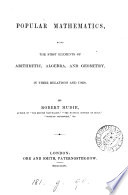 | Robert Mudie - Mathematics - 1836 - 542 pages
...product, and + a 6 — a 6 is =0, and may be left out in adding. Hence we have this principle : — the product of the sum and difference of two quantities is equal to the difference of their squares. If we subtract the square of a — 6 from that of a +6, we have, 4ab — difference. Therefore, four... | |
 | Silas Totten - Algebra - 1836 - 360 pages
...place of a and b, it follows, that this property is general. This property may be thus enunciated : — The product of the sum and difference of two quantities is equal to the difference of their squares. Having demonstrated this property, we can make use of il to shorten the operation of multiplication... | |
 | 1837 - 136 pages
...of this rule is evident from 47. I. and from a Cor. to 5. II. which says, that the rectangle under the sum and difference of two quantities is equal to the difference of their squares. (Page 33.) 17. By the 8. VI. AB X BD = BC2. Hence, BD B С2 = -T~D, which is one part of the rule.... | |
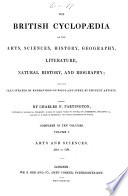 | Charles Frederick Partington - Encyclopedias and dictionaries - 1838 - 1116 pages
...minus twice the product of the first and second. 3°. That (a + i) (a — i) = a3 — i3 ; or, that the product of the sum and difference of two quantities is equal to the difference of their squares. These examples are of very frequent occurrence in algebra, and their results should be well remembered,... | |
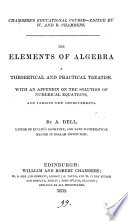 | Andrew Bell (writer on mathematics.) - 1839 - 500 pages
...example ; and therefore а + x is the sum, and а—x the difference of a and x, hence; — (70.) 1 The product of the sum and difference of two quantities is equal to the difference of their squares.1 * EXERCISES. 1. Multiply 2a2 — 4 ая: + 2 ж2 by За — Zx 2. Multiply 3 a4 + 3ж4 by... | |
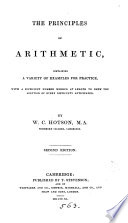 | Wales Christopher Hotson - 1842 - 306 pages
...Required the square of a + b. a -\-b a +b a?+ ab (4) Multiply a + b by a — b. Hence it appears, that the product of the sum and difference of two quantities is equal to the difference of their squares, which is proved in Prop. 5, Book n. of Euclid's Elements, and furnishes a most useful rule for the... | |
 | Davis Wasgatt Clark - 1844 - 394 pages
...or a+^/b, are called binomial surds, and may be reduced to rational quantities on the principle that the product of the sum and difference of two quantities is equal to the difference of their squares. Thus the binomial surd v/a+v/6 Multiplied by - . v/o — -J/b — Vab+b Gives - - . a +b, n. rational... | |
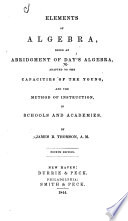 | James Bates Thomson - Algebra - 1844 - 272 pages
...y"y3. 20. If a-\-b be multiplied into a — b, the product will be a2— 62, (Art. 86 ;) that is, 19 1. The product of the sum and difference of two quantities, is equal to the difference of their squares. This is an instance of the facility with which general truths are demonstrated in algebra. If the sum... | |
 | Horatio Nelson Robinson - Algebra - 1844 - 184 pages
...parts. Also, that («-|-i)(a — i)=a2 — b-. Or (a4+i4)O4— J4)=a2— b2. That is, the rectangle of the sum and difference of two quantities is equal to the difference of their squares. By this last observation we readily perceive that a4— b4, or any other binomial having a minus sign... | |
 | James Bates Thomson - Algebra - 1844 - 272 pages
...multiplied into a — 6, the product will be a2— b2, (Art. 86 ;) that is, 191. The product ofthesum and difference of two quantities, is equal to the difference of their squares. This is an instance of the facility with which general truths are demonstrated in algebra. If the sum... | |
| |